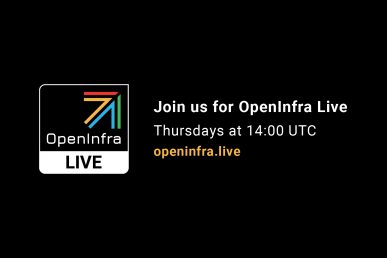The OpenInfra Edge Computing Group met online at the recent Project Teams Gathering (PTG) event to grab the opportunity to dissect the edge computing space even further. During this PTG, we explored activities both in Europe as well as globally. This time the focus was on what connects multiple edges together, both from an infrastructure and social perspective.
Our session started with a series of presentations, delivered by Andreas Florath (Deutsche Telekom), to introduce the EU Cloud Alliance (European Alliance for Industrial Data, Edge and Cloud) and the current work to build a federation of edge systems in Europe. The EU Commission supports this effort and many other projects, such as Gaia-X and Horizon Europe. These projects typically have a focus on different, but connected areas, such as data, automotive or the cloud-to-edge continuum.
The EU Cloud Alliance assists the EU Commission by supporting the creation and deployment of next-generation cloud capacities for the public and private sector. Their objective is to specify the requirements for next-generation of secure, low-carbon and interoperable cloud and edge services and infrastructure, based on the three pillars of cloud, compute, networking and storage. The EU Cloud Alliance has an Edge/Cloud Working Group, that organized its activities into task forces. The scope that these groups cover ranges from the cloud and edge landscape in Europe, through cybersecurity up to application and data services.
The Alliance executes its mission through activities such as:
- Giving recommendations in the form of use cases, technology roadmaps and more
- Determining challenges for requirements and standards of cloud services
- Keeping a focus on data requirements, especially on how to best host sensitive data, which comes with high-security requirements
Open source plays a key role in the activities and projects of the EU Commission, which is often reflected in the projects’ requirements. Some even set it as a goal to open source everything. Funding levels also vary based on the amount of open source components used and produced as part of the projects’ artifacts.
After the overview of the EU Cloud Alliance, the group moved on to a review of the ongoing work defining and building a federation of edge-cloud continuum in Europe. By 2030, 10000 climate-neutral, highly-secure edge nodes are planned to be deployed throughout Europe. The scope of the federation covers the end-to-end infrastructure. The scale of infrastructure reflects on the edge-cloud continuum, as these nodes need to be connected and managed without any artificial separation within the elements.
Federation is used to create the connection and provide access to the components. While these components are not managed by one single provider but rather many of them, the aim is to have access to them through a single platform. If the implementation is successful, the cloud federation layer will hide the underlying infrastructure providers. It will also provide a consistent platform, as well as a consistent experience for all application providers and users. While that might seem like a worthy goal, can one platform rule them all? There are a few obstacles to overcome first:
- SD-WAN limitations: if the number of nodes grows too big, it will prompt the need for a hierarchical system
- The EU-wide scope also posts a complication as multiple infrastructure and application providers may or may not span across country borders
The layers of the stack consist of the ‘infrastructure provider’ layer, the ‘edge-cloud federation’ layer, the ‘application provider’ layer, and a ‘marketplace’ layer, with the ‘users’ being displayed on top. The layers demonstrate the complexity of the underlying systems, while also showing the intention to make it user-friendly. As we talked about requirements, the conversation resembled other edge-related discussions. Security was on the top of our list, while we added hardware independence as a new item. The biggest challenge that needs to be addressed is how to achieve fault tolerance throughout the system.
While in Europe the intent is to build an agnostic solution that uses different open source building blocks. there are other efforts in the open source ecosystem to address federation-related functionality. Ongoing work in the global community includes the Anuket project, as well as MEF, where the focus is on defining APIs to provide standard access points that can be used to connect the elements. There are past efforts, like grid computing, that was in fashion over a decade ago, or current solutions such as Wireguard, which is a de-facto overlay standard for networking, that carry a lot of resemblance to building a federated system.
The ongoing work in this area is somewhat fragmented. GSMA is one of the organizations that are working on a federation API proposal, which is already partially implemented. This group, however, has a strong telecom focus and a private membership, which is not always seen as desirable within the wider open source community. Beyond GSMA, the CAMARA project and TMForum are groups that are working on proposals that are leading to API slicing.
It has been true for a while, but the Edge is a very fragmented and overly complex ecosystem. Just looking at the projects within OpenInfra many can and are used to support Edge architectures and use cases, like OpenStack and StarlingX. For instance, OpenStack was utilized for a uCPE use case before the OpenInfra Edge Computing Group was even created. StarlingX is powering large, distributed vRAN deployments around the globe.
For containerized edge applications, Kata Containers, which is a container runtime that delivers security and speed in one package by creating a fusion between virtual machines and containers, is a desired choice. It provides increased security, compared to traditional containers, and the ability to use a different kernel than what is running on the host machine, it can be a very appealing solution for the edge space. The Kata Containers community also collaborates with the Confidential Computing group in the CNCF ecosystem, which has been gaining increased community interest recently.
One member of the discussion also shared a document that shows over 150 open source projects and libraries that are relevant for the edge. How many of these projects are primarily relevant for edge? We are not sure. But the number in itself shows that consolidation of projects in this space is long overdue.
Last but not least, it has become increasingly clear that today’s systems with their massive scale and distributed nature create a level of complexity that is hard to manage. While simplicity is always a goal, it is not something that can be accomplished for an end-to-end infrastructure, without much more community will and support than what currently exists. However, while systems can remain complex, managing them doesn’t have to be as long as there is a focus on increasing the tools to support automation, then operating and maintaining a distributed edge infrastructure could become a relatively easy task.
If you missed the event and would like to listen to the sessions you can access the recordings on the OpenInfra Edge Computing Group wiki. The group has a list of follow-up discussions and presentations scheduled already! Check out our lineup and join our weekly meetings on Mondays to get involved!
About OpenInfra Edge Computing Group:
The Edge Computing Group is a working group comprised of architects and engineers across large enterprises, telecoms and technology vendors working to define and advance edge cloud computing. The focus is on open infrastructure technologies, not exclusive to OpenStack.
Get Involved and Join Our Discussions:
- Weekly Meetings
- Join the Mailing List
- Cloud Edge Computing: Beyond the Data Center White Paper
- Edge Computing: Next Steps in Architecture, Design and Testing
The Edge Computing Group will also host a Forum session at the OpenInfra Summit. Register today and stay tuned for more details on that session!
- Cloud Platform Monitoring, Digital Twins and a Real-time Context Broker - August 2, 2023
- StarlingX is 5 Years Old, and more from the OpenInfra Summit - July 11, 2023
- StarlingX is Turning 5! - June 13, 2023

)









